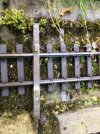Having just started to build garden layout fixed on wooden posts with track on wooden cross pieces covered by thin roofing felt, what are the best screws or nails to use? Track is aristocraft. Once it's fixed and I am happy with positioning will then ballast. Many thanks for any advice.
You are using an out of date browser. It may not display this or other websites correctly.
You should upgrade or use an alternative browser.
You should upgrade or use an alternative browser.
Track fixing screw or nail
- Thread starter Dgs8899
- Start date
korm kormsen
Registered
any nails, that get rusty. stainless nails slip out again over time.
Greg Elmassian
Guest
I am against tightly fixing track to anything, for most people it ends in tears. Find a loose way to fix the track and let it move somewhate in the ballast like the real thing.
Greg
Greg
I have used a bit of both. My choice is for small nails with a Flat Round Head that go into a slightly oversized hole drilled to the outside bit of the sleeper each side of the rail. Do not be tempted to bang them in too far. My friend uses horrible Copper coloured Nails with a splurge as the head that damage the track severely, keep on telling him not to use them but he still does. Trashes the Chairs as there is no flexibility.
If you use Screws use Round Headed Real Brass Ones again outside of the Rail and again with a little bit of movement allowed though this means larger holes in the Sleepers.
Depending on how you Ballast the Track long term life of the Nails or Screws is probably irrelevant, many of the Steel Nails I used have rusted away but as my Ballast is glued with PVA External Variety let down 40/50 with water the fixings become irrelevant.
If you use Screws use Round Headed Real Brass Ones again outside of the Rail and again with a little bit of movement allowed though this means larger holes in the Sleepers.
Depending on how you Ballast the Track long term life of the Nails or Screws is probably irrelevant, many of the Steel Nails I used have rusted away but as my Ballast is glued with PVA External Variety let down 40/50 with water the fixings become irrelevant.
That is why you need to use real Brass Screws, no Rust!You don't want this if you need to pull it up.
This I'm told is in excellent condition from a German train dealer even though the eBay ad was picture perfect. He refused to understand what my problem was when I insisted on a discount. I'll nail him.
View attachment 255385
Gerard
Registered
Hello, i used another approach to this problem: thin plated copper strips with on top two small weldon curved shapes that fit inside the underside outer ends of the sleeper. The strip can either be bended and pushed into the soil or between the bricks , or can be mounted on a wooden layer with screws. The result is a track laying loose but in the proper horizontal position. The copper will oxidide to the same color as the brass rail, so it looks rather natural. See photo.
Attachments
Madman
Registered
Wow, do you think your bridge spans are strong enough to support that train.....Definitely use screws not nails, preferably rust-proof. Easier to drive in and out.
My line was near ground level fixed to a long thin framework rather than directly on the ground. I used screws on the outside of the sleepers rather than in the middle.
View attachment 255401



